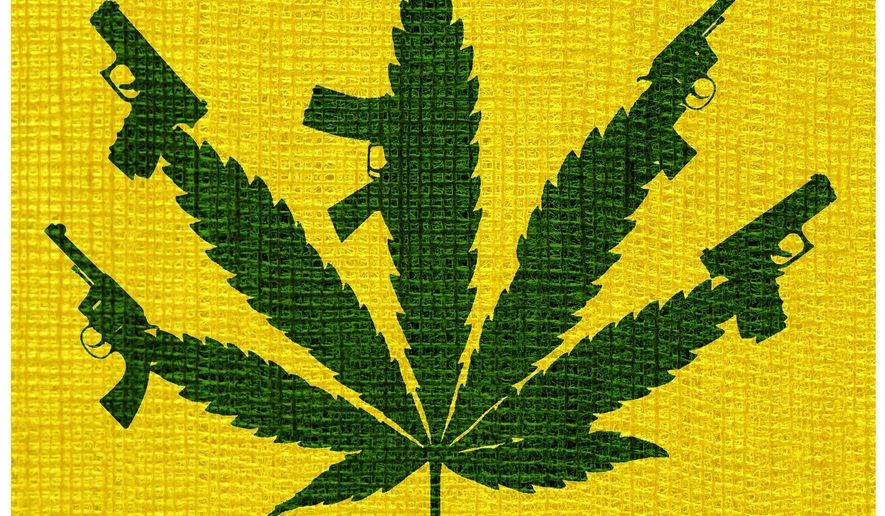OPINION:
Violent crime has spiked in many U.S. cities over the last year, including a 54 percent increase in homicides in Washington, D.C. in 2015 — as well as 63 percent in Baltimore and 13 percent in Chicago. It is no coincidence that this uptick comes at a time when drug laws are being loosened throughout the country. Twenty-three states and the District of Columbia have legalized or decriminalized marijuana, either for medical purposes or overall.
Last year, D.C. Police Chief Cathy Lanier told NewsChannel 8 that decriminalizing marijuana “saves us from having to charge someone for small amounts of marijuana now, because it really never was productive to begin with.” As someone who wants to reduce crime, she may not be aware that marijuana legalization does not necessarily decrease crime, and possibly increases it. In Seattle, one of the four states along with the District that has legalized recreational use of marijuana, violent crime has increased by 6 percent since the marijuana law was passed.
Granted, many believe marijuana makes people docile. However, according to a study called “Is Marijuana a Gateway Drug?” from the Eastern Economic Journal, “Marijuana intoxication may spawn curiosity or diminish apprehension about trying more dangerous drugs.” Another article titled “Youth Violence, Guns, and the Illicit-Drug Industry” from The Journal of Criminal Law and Criminology, says, “Because those [drug] markets are illegal, the participants must arm themselves for self-protection, and the resulting arms race among young people results in more frequent resorting to guns.”
Drug abuse and crime have increased since federal anti-drug advertising funding has been cut and now zeroed out for the bipartisan federal youth anti-drug campaign created by Clinton drug czar and four-star general, Barry McCaffrey, and House Speaker Newt Gingrich in 1998. There was a 30 percent drop in youth drug use during the U.S. anti-drug media campaign’s peak years, 1998-2001, when the government put $100 million a year into TV ads, matched by television networks for a total of $200 million a year. That five-year, billion-dollar campaign has ended. It should be restored.
The current “Above the Influence” White House campaign is a pale imitation, simply funneling money to local organizing efforts. It doesn’t air powerful and effective national TV ads. Does anyone think Coca-Cola doesn’t air TV ads?
Law enforcement officers, health officials and elected officials know the damage and costs that are done by marijuana in car crashes, driving under the influence arrests and date rape. Alcohol, marijuana and other drugs used in combination with them are causing a flood of cases in already-overcrowded emergency rooms. Most “legalizers” claim they want to separate marijuana from “harder” drugs, but it cannot be done. For example, 41 percent of patients with bipolar disorder have a dependence on marijuana (“Effects of Co-occurring Cannabis Use Disorders on the Course of Bipolar Disorder After a First Hospitalization for Mania” JAMA Psychiatry 2007).
Another issue is that District of Columbia residents don’t even know how many people are being prosecuted for violent offenses and, therefore, what causes them. Advisory Neighborhood Commissioner Denise Rucker Krepp started a petition on Change.org and testified in front of the D.C. City Council on Feb. 11 to ask how many people are being prosecuted.
FBI director James Comey blames the increase in violent crimes on the “Ferguson Effect.” Mr. Comey said officers feel “under siege” by cellphone cameras and are reluctant to do their jobs. He said his officers tell him, “We don’t feel like being that guy in the video.’”
This contention neglects the reason why black youth take those cell phones out in the first place. It’s based on events in Ferguson, Baltimore, Cleveland, New York, Charleston and other cities in which police shot an unarmed black “suspect.”
President Obama publicly took on his own FBI director. “We do have to stick with the facts,” Mr. Obama told the International Association of Chiefs of Police. “We can’t cherry-pick data or anecdotal evidence to drive policy or feed political agendas.”
Past and present U.S. attorneys general also disagree with Mr. Comey. The Department of Justice filed a lawsuit on Feb. 10 to force the Ferguson police department to reform the way it operates. Attorney General Loretta Lynch cited the problem as police culture, not cellphone videos. In fact, the Justice Department found in Phoenix a 23 percent drop in complaints against officers with body cameras versus a 10 percent increase without.
Another factor in violent crime is the background checks Congress has stalled but the American people support by 92 percent, according to a CBS/New York Times poll from Oct. 27. Missouri repealed a bill in 2007 that since 1921 had required background checks on all handgun purchases. Since the 2007 repeal, the murder rate in Missouri has gone up 14 percent, the firearm homicide rate 25 percent and the firearm suicide rate 16.1 percent.
Drugs and people using firearms, not cellphone cameras, have caused the spike in violent crime. It’s time for expanded drug treatment, and expanded background checks for gun purchases, not convenient rationalizations by law enforcement. And certainly not expanded drug legalization.
• Robert Weiner is former spokesman for the White House National Drug Policy Office and the House Narcotics Committee. Ben Lasky is senior policy analyst at Robert Weiner Associates and Solutions for Change.




Please read our comment policy before commenting.